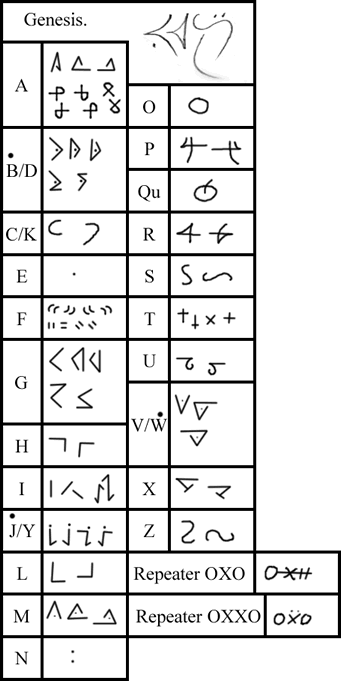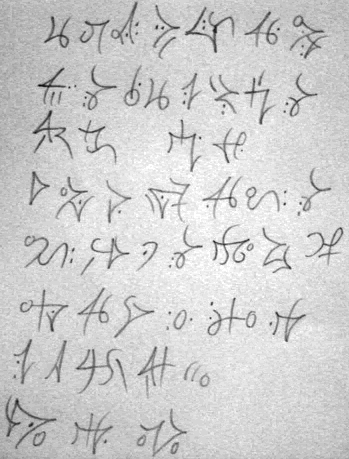Genesis
The Genesis alphabet was invented by Mike Gibson as alternative
way to write English. It is an alphabetic writing system in which
the letters are merged and rearranged in order to create glyphs.
He designed it for English, but it could be modified to write any
language which uses Roman characters.
Notable features
- Type of writing system: alphabet
- Direction of writing system: left to right in horizontal lines
- Used to write: English - could be modified to write any language that uses Roman letters
Genesis alphabet

Most of the symbols resemble their Roman counterparts, so if it
was written purely alphabetically, it'd be relatively easy to decode.
It's quite complex but all the rules are there for a reason; it's
actually quite easy to read/write once you get the hang of it.
There is plenty of freedom with this system and you can write it
however you want, just so long as you can read it back again without
any problems. The rules below are what I designed the system around
and it flows best when following these guidelines:
- When writing a word, the letters are rearranged by taking
them in pairs and switching the letters in that pair. 'Word'
is split into wo+rd and the pairs are switched ie. ow+dr. 'Yes'
becomes 'eys', 'takes' becomes 'ateks', and so on. When reading
it back, you follow the same pattern.
- Before you switch anything, no doubles! Hello is written as
ehol, not ehllo. Ball becomes abl, sitting becomes isitgn, and so
on. This could be read as siting, but the context of the sentence
takes care of that. is because...
 The reason we eliminate doubles before switching
The reason we eliminate doubles before switching
- Switching creates doubles. Barb becomes abbr (ab"r), cork becomes
okkr (ok"r) etc. In these cases, instead of writing the same symbol
twice, we just write it once with a double dot above it to signify
that it needs to be read twice. Examples:
- There is another repeater which can be used for aesthetic reasons.
It's rarely needed but comes in handy when the same symbol appears on
either side of another. Instead of having the same symbol either side,
we write the second one as a horizontal line with 2 vertical strokes.
One example of its use would be 'lava' (alav). Instead of writing this
as 'al av' it can fit into one glyph. See right:
- Few words will fit into a single glyphthough, regardless of how you
try to fit it all together. You will need to break most words up because
of the way things join together; if something doesn't join then you need
to break it off into the next glyph.
- Switching doesn't carry. The second letter in any glyph is always going
to be the first you read, to avoid confusion. The word "switching", for example,
would be written as "wsi ctih gn" because of how things join. It would NOT
be written as "ws tih cn ig". See example on the right:
- Having dots all over the place looks very untidy and can sometimes cause
confusion, so any time you get E and N beside each other you join the dots
into a triangle. A left pointing triangle is 'en', which is read back as 'ne',
and vice versa. You can see this in the name of the script itself, Genesis
(eg en is"). If they appear either side of a symbol they're fine, so only join
them into a triangle when they're right beside each other.
If you get other clusters, you can join those into a square or diamond if you wish. Just so long as you can read it again afterwards.
- D and B are almost identical apart from the dot. Same with J/Y, V/W, and
A/M... although the placement of the dot is especially important when it comes
to B. It has to be in the crook. Below are some examples of B and D, and the roles
different dots play:

Last but not least, some letters have more than one form (or can be reversed),
so you can use whichever flows the best or simply what you like the look of more.
Just make sure not to flip anything which will become a different letter by doing so.
Sample text

Transliteration
All human beings are born free and equal in dignity and rights. They
are endowed with reason and conscience and should act towards one another
in a spirit of brotherhood.
(Article 1 of the Universal Declaration of Human Rights)
Constructed scripts for: Ainu |
Arabic |
Chinese languages |
Dutch |
English |
Hawaiian |
Hungarian |
Japanese |
Korean |
Lingala |
Malay & Indonesian |
Persian |
Tagalog / Filipino |
Russian |
Sanskrit |
Spanish |
Taino |
Turkish |
Vietnamese |
Welsh |
Other natural languages |
Colour-based scripts |
Tactile scripts |
Phonetic/universal scripts |
Constructed scripts for constructed languages |
Adaptations of existing alphabets |
Fictional alphabets |
Magical alphabets |
A-Z index |
How to submit a constructed script
[top]

You can support this site by Buying Me A Coffee, and if you like what you see on this page, you can use the buttons below to share it with people you know.

If you like this site and find it useful, you can support it by making a donation via PayPal or Patreon, or by contributing in other ways. Omniglot is how I make my living.
Note: all links on this site to Amazon.com , Amazon.co.uk
, Amazon.co.uk and Amazon.fr
and Amazon.fr are affiliate links. This means I earn a commission if you click on any of them and buy something. So by clicking on these links you can help to support this site.
are affiliate links. This means I earn a commission if you click on any of them and buy something. So by clicking on these links you can help to support this site.
[top]

 The reason we eliminate doubles before switching
The reason we eliminate doubles before switching



, Amazon.co.uk
and Amazon.fr
are affiliate links. This means I earn a commission if you click on any of them and buy something. So by clicking on these links you can help to support this site.